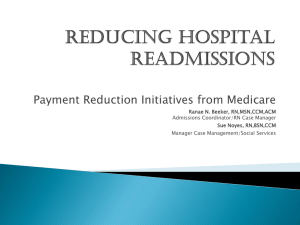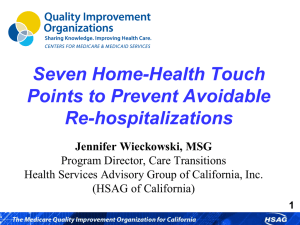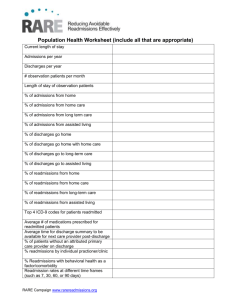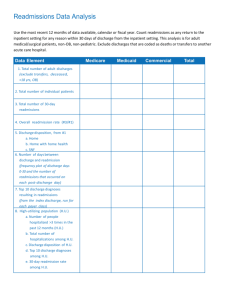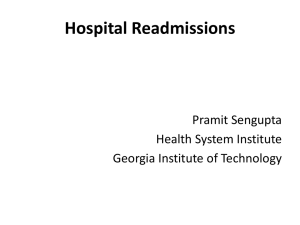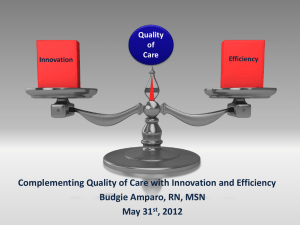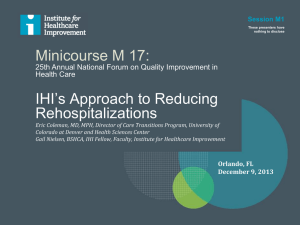Reduced Readmissions: Reform's Low
advertisement
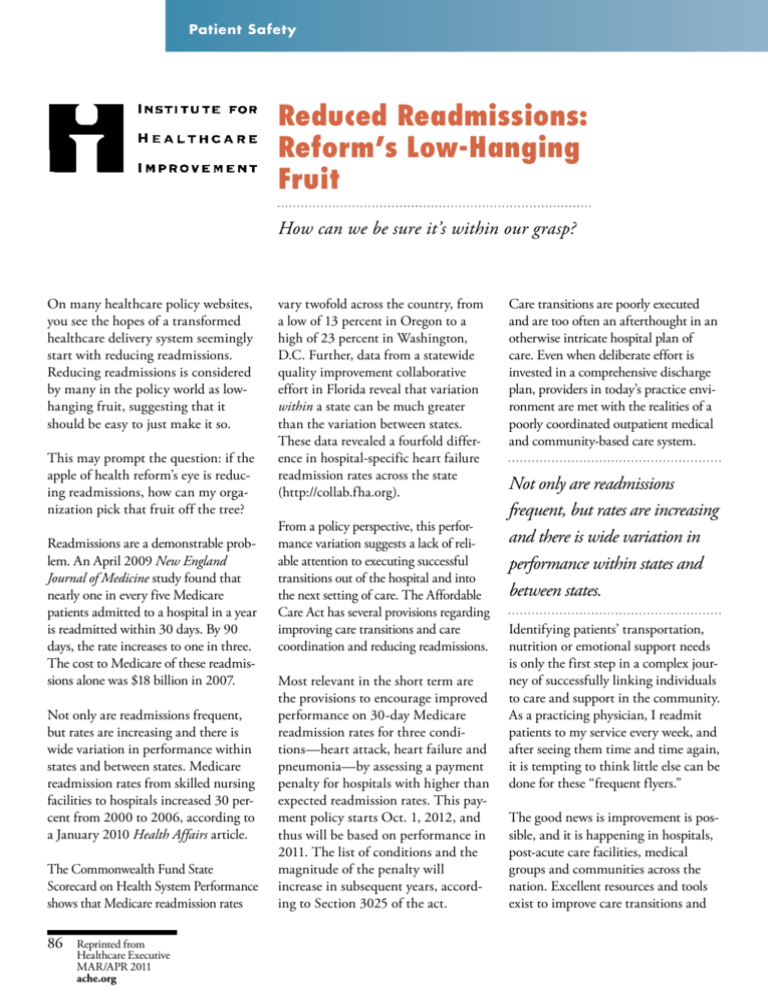
Patient Safety Reduced Readmissions: Reform’s Low-Hanging Fruit How can we be sure it’s within our grasp? On many healthcare policy websites, you see the hopes of a transformed healthcare delivery system seemingly start with reducing readmissions. Reducing readmissions is considered by many in the policy world as lowhanging fruit, suggesting that it should be easy to just make it so. This may prompt the question: if the apple of health reform’s eye is reducing readmissions, how can my organization pick that fruit off the tree? Readmissions are a demonstrable problem. An April 2009 New England Journal of Medicine study found that nearly one in every five Medicare patients admitted to a hospital in a year is readmitted within 30 days. By 90 days, the rate increases to one in three. The cost to Medicare of these readmissions alone was $18 billion in 2007. Not only are readmissions frequent, but rates are increasing and there is wide variation in performance within states and between states. Medicare readmission rates from skilled nursing facilities to hospitals increased 30 percent from 2000 to 2006, according to a January 2010 Health Affairs article. The Commonwealth Fund State Scorecard on Health System Performance shows that Medicare readmission rates 86 Reprinted from Healthcare Executive mar/apr 2011 ache.org vary twofold across the country, from a low of 13 percent in Oregon to a high of 23 percent in Washington, D.C. Further, data from a statewide quality improvement collaborative effort in Florida reveal that variation within a state can be much greater than the variation between states. These data revealed a fourfold difference in hospital-specific heart failure readmission rates across the state (http://collab.fha.org). From a policy perspective, this performance variation suggests a lack of reliable attention to executing successful transitions out of the hospital and into the next setting of care. The Affordable Care Act has several provisions regarding improving care transitions and care coordination and reducing readmissions. Most relevant in the short term are the provisions to encourage improved performance on 30-day Medicare readmission rates for three conditions—heart attack, heart failure and pneumonia—by assessing a payment penalty for hospitals with higher than expected readmission rates. This payment policy starts Oct. 1, 2012, and thus will be based on performance in 2011. The list of conditions and the magnitude of the penalty will increase in subsequent years, according to Section 3025 of the act. Care transitions are poorly executed and are too often an afterthought in an otherwise intricate hospital plan of care. Even when deliberate effort is invested in a comprehensive discharge plan, providers in today’s practice environment are met with the realities of a poorly coordinated outpatient medical and community-based care system. Not only are readmissions frequent, but rates are increasing and there is wide variation in performance within states and between states. Identifying patients’ transportation, nutrition or emotional support needs is only the first step in a complex journey of successfully linking individuals to care and support in the community. As a practicing physician, I readmit patients to my service every week, and after seeing them time and time again, it is tempting to think little else can be done for these “frequent flyers.” The good news is improvement is possible, and it is happening in hospitals, post-acute care facilities, medical groups and communities across the nation. Excellent resources and tools exist to improve care transitions and Patient Safety reduce readmissions. Clinical and administrative executives play an essential role in framing the approach to reducing readmissions. Based on our experience in the STAAR (STate Action on Avoidable Rehospitalizations) initiative, the Institute for Healthcare Improvement (IHI) recommends the following concepts as key framing opportunities for healthcare executives. Focus on the person, not the condition. In response to disease-specific research findings or payment policy incentives, many organizations may be focused on reducing readmissions for certain diseases only, such as heart failure. On one hand, this allows quality improvement efforts to focus on a defined patient population, which is helpful. Our experience suggests that changing processes and norms and transforming care to achieve improved performance across an organization will benefit from taking a personcentered approach. Disease-specific efforts require case finding, which can be laborious and rely on administrative data that may omit from view individuals with heart failure for whom that was not a primary issue during hospitalization (such as a patient who was admitted for a hip replacement). Clinical and administrative executives can play an essential role in framing readmissions as a personcentered effort to minimize the likelihood of an early, unexpected return to the hospital for any reason to any service. Know your data. On one level, we are still somewhat hamstrung by the lack of a national, uniformly adopted, 30-day readmission measurement definition. This can present a challenge for executives who seek to benchmark performance with peers. On another level, the most important measure to understand is the one your organization decides on, tracks over time and feeds back to managers and frontline staff. Establish what success looks like. Reducing readmissions—especially for hospitals—is an opportunity to bring the clinical, financial and strategic leadership teams’ perspectives to bear. Clinical quality efforts may achieve desired outcomes, but if success comes at an unanticipated cost to the organization, those achievements may fail to be sustained. Perform a clinical and financial analysis of readmissions in today’s current environment, model what a 30 percent reduction in readmissions would mean and forecast how future payment incentives or penalties change that analysis. The results of these analyses may lead to strategic planning efforts to sustain a successful reduction in baseline readmission volume. Form a cross-continuum team. Success in reducing readmissions will require new partnerships, communication and linkages outside the walls of a hospital or clinic. Healthcare leaders can establish these partnerships based on a common goal of improving transitions across settings. In essence, reducing rehospitalizations in a catchment area or community requires a coalition of providers and organizations with aligned priorities and activities to achieve measurable outcomes. 88 Reprinted from Healthcare Executive mar/apr 2011 ache.org Improve the discharge process. In essence, this requires a move from the concept of “discharge” (to be done with) to the concept of “transition.” Successful improvements to the discharge process focus on transitioning the patient to the next setting of care with complete information, a clear plan of care, timely follow-up and appropriate support services. The essential elements of a comprehensive discharge process should be executed consistently. This concept also applies to the transition from a short-term rehabilitation facility or nursing home to the ambulatory setting. Mobilize enhanced transitional care support for individuals at high risk of readmission. Recognize that current best practices for transition out of a hospital and into the next setting of care will still not suffice for a subset of medically or socially complex patients. Hospitals, medical groups, payors and community-based aging services are mobilizing enhanced services for the weeks immediately following a hospitalization, according to research published in a February 1999 issue of JAMA and in a September 2006 issue of the Archives of Internal Medicine. Engage patients and families. Efforts to improve care transitions and reduce rehospitalizations should involve patients and families at every level of the organization: from the personal experience of care at the bedside, to the process improvement efforts on a unit or in an office, to the systems put in place at the organizational level. In the STAAR initiative, patients are engaged in the daily plan of care, establishing goals, and in active teaching and learning based on evidence-based health literacy principles. Additionally, patients and caregivers are invited to participate on hospitalbased cross-continuum teams to inform the redesign of transition processes between settings. Practically, shifting the focus from providers teaching patients and families to assessing what they are learning has proven to be an exciting new paradigm for frontline providers. Cross-continuum teams in IHI’s STAAR initiative and other readmissions collaboratives are applying the approaches detailed above to their own settings: hospitals, post-acute rehabilitation facilities, long-term care, home healthcare, ambulatory practices, and home and communitybased services. In addition, teams in the STAAR initiative are concentrated in four states, fostering a regional movement that can be leveraged to raise awareness and coordinate statewide priorities and activities. Done well, with a focus on individuals over time and across settings, reducing avoidable readmissions can be a core part of transforming the healthcare delivery system. Readmissions are measurable and actionable for improvement at the front lines of care. Because improving care transitions requires a whole-person, longitudinal, cross-setting perspective, efforts to reduce readmissions are at the heart of achieving a more coordinated, patientcentered care system. s Amy E. Boutwell, MD, is director of Health Policy Strategy at the Institute for Healthcare Improvement. She can be reached at aboutwell@ihi.org. Reprinted from Healthcare Executive mar/apr 2011 ache.org 89
